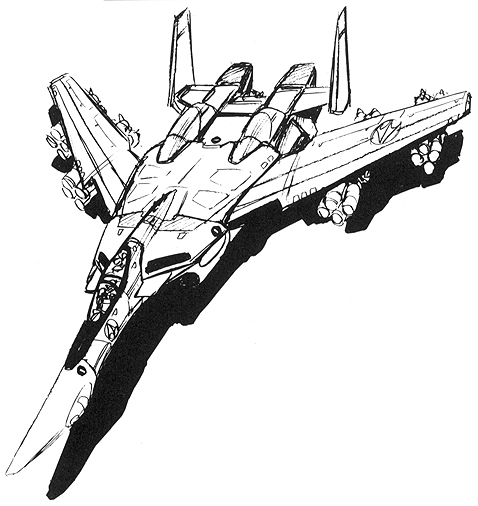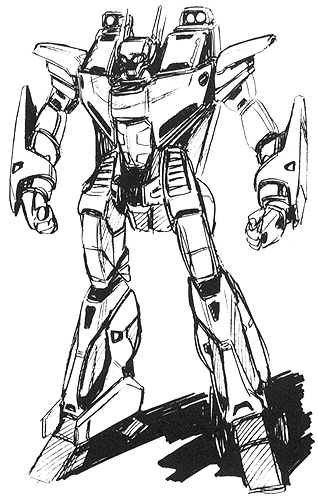-
Posts
219 -
Joined
-
Last visited
Content Type
Profiles
Forums
Events
Gallery
Everything posted by Devil 505
-
-
- 20137 replies
-
- macross delta
- vf-31 siegfried
-
(and 4 more)
Tagged with:
-
This mash-up is so wrong, yet so right.
-
It must be a problem on mobile. I just re-uploaded them, and it seems to work fine on my phone.
-
I was wondering about that. In the atmosphere, the plasma trail is from the superheated air, but what about in space?
- 800 replies
-
- discussion
- variable fighters
-
(and 1 more)
Tagged with:
-

New Macross TV Series in 20xx (sometime this decade)
Devil 505 replied to Tochiro's topic in Movies and TV Series
Two if you count the YF-29B. The SV-51/52 has the excuse of being partially designed by the Russians. If I recall correctly, later VFs have the ISC stored in the nose, which explains the larger nose. As for the Sv-262, it's no different than the VF-0/1/25 ripping off the F-14, the YF-21/VF-22 ripping off the YF-23, or the Sv-154 (via the LV-7) ripping off the F-104. -

New Macross TV Series in 20xx (sometime this decade)
Devil 505 replied to Tochiro's topic in Movies and TV Series
I'm quoting the Macross Mecha Manual article on the YF-24, if Mr. March or Seto Kaiba would like to correct me: (bolded for emphasis). -

New Macross TV Series in 20xx (sometime this decade)
Devil 505 replied to Tochiro's topic in Movies and TV Series
Actually, it's vice versa. -

New Macross TV Series in 20xx (sometime this decade)
Devil 505 replied to Tochiro's topic in Movies and TV Series
It's probably a longshot, but I'd love to see the YF-24 in action, rather than just diagrams. -
Now I'm wondering if we'll ever see "beam shrouded projectiles" like the Bowcaster rounds in Star Wars, or the "Plasma Infused" weapons in Fallout.
- 800 replies
-
- discussion
- variable fighters
-
(and 1 more)
Tagged with:
-
It seemed obvious to me. An enemy fighter with the number "262" definitely invokes the Messerschmitt to anyone who knows their aircraft.
- 7072 replies
-
- newbie
- short questions
- (and 22 more)
-
The VF-25G, VF-31, Sv-262, and VF-2SS having railgun projectiles as examples.
- 800 replies
-
- discussion
- variable fighters
-
(and 1 more)
Tagged with:
-
Call me a Luddite, but I've always preferred good old-fashioned kinetic weaponry.
- 800 replies
-
- discussion
- variable fighters
-
(and 1 more)
Tagged with:
-
The book The Science of Battlestar Galactica talks about real world science and technology in relation to the re-imagined series. In one chapter, they go into detail on why ballistic weaponry was used instead of directed energy. It stated that 100kW is considered to be the bare minimum for a weapons-grade laser. In comparison, the cancelled YAL-1 airborne laser used a 1,000kW laser to intercept ballistic missiles. Whenever I think about that, I'm reminded of the "Self Sealing Stem Bolts" from Star Trek: Deep Space Nine. Looking at the main nozzle in relation to the lift nozzles, it does seem a bit reminiscent of a VF-22 in GERWALK mode. You would think with the intake air acting as a coolant, those thrust figures would be reversed.
- 800 replies
-
- discussion
- variable fighters
-
(and 1 more)
Tagged with:
-
I probably read it wrong, but I thought the VF-22HG also had its leg thrusters upgraded? You got a point there. Looking at it now, the VF-22's engine placement does remind me of the ill-fated X-32B, which if I remember correctly, had center of gravity issues. One could argue that the lower fuel capacity is balanced by the engines having to throttle back in space due to cooling issues, but I'd just be splitting hairs. Even the VF-22 has external hardpoints and Super Packs, if the VF-22 Master File counts, which invalidates my argument. Another good point, as much as I dislike falling back to Overtechnology as the sole explanation. Modern fighters like the F-22 have sensors embedded throughout the airframe, which could provide some level of redundancy, in combination with helmet-mounted displays, but I see what you're getting at. On a related note, at least one company is designing an airliner that eliminates passenger windows in favor of flat panel displays. This is being done to reduce weight and fuel consumption. I also like the SW-XA1 Schneeblume for a more stealthy and realistic take on the VF-1. I'd be willing to pay good money if someone did a similar design based on the VF-25.
- 800 replies
-
- discussion
- variable fighters
-
(and 1 more)
Tagged with:
-

New Macross TV Series in 20xx (sometime this decade)
Devil 505 replied to Tochiro's topic in Movies and TV Series
Does anyone remember this old thread? -
Agreed. Attempting to get back on topic here, I always felt that the VF-22 could do with a Frontier-era modernization, but that was already covered with the VF-22HG in Macross the Ride. My personal (if not controversial) opinion, the basic design of the YF-21/VF-22 is one of the most realistic designs for a space fighter in general, especially in terms of atmospheric entry and flight. Super Packs notwithstanding, the internal and conformal loadout of the Omega 1/Sturmvogel II/Schwalbe Zwei allows for minimal drag for high-speed atmospheric flight, as well as stealth. That's one of the reasons the F-106 Delta Dart is one of my favorite Cold War-era fighters. On top of that, the wing design allows for a "waverider" effect which assists in high speed atmospheric flight and reentry as well. That being said, the SV-262's canopy is the most practical, considering the weakness of "traditional" canopies. NASA has been experimenting with "External Vision Systems" involving covered canopies and external canopies for future supersonic and hypersonic aircraft.
- 800 replies
-
- discussion
- variable fighters
-
(and 1 more)
Tagged with:
-
The VR is exclusive to PS4.
- 577 replies
-
- namco
- ace combat 7
-
(and 4 more)
Tagged with:
-

New Macross TV Series in 20xx (sometime this decade)
Devil 505 replied to Tochiro's topic in Movies and TV Series
I honestly wouldn't mind an all-guy triangle. Yuri on Ice did it pretty well. -

New Macross TV Series in 20xx (sometime this decade)
Devil 505 replied to Tochiro's topic in Movies and TV Series
All this complaining is starting to sound like the forums for The-Show-That-Must-Not-Be-Named. Having lurked there, they've done nothing but complain about Delta, and Macross in general, and they've got nothing but nostalgia to go by. -
Even now, Reaction Engines, Ltd. came up with heat exchangers for their SABRE precooled air breathing rocket engine that rapidly cools the intake air to -150°C. The best materials I've seen so far in real life would be Ultra-High Temperature Ceramics, which would provide thermal protection up to over 2,000°C. It's stated that said materials would allow sustained Mach 7 flight at sea level.
- 800 replies
-
- discussion
- variable fighters
-
(and 1 more)
Tagged with:
-

New Macross TV Series in 20xx (sometime this decade)
Devil 505 replied to Tochiro's topic in Movies and TV Series
As someone who migrated from The-Show-That-Must-Not-Be-Named to Macross, I've definitely enjoyed what Macross has to offer in comparison to those other guys. The fact that I have a "ponified" Basara as my avatar should say enough. I'm always looking forward to what comes next for Macross, for better or worse. -

New Macross TV Series in 20xx (sometime this decade)
Devil 505 replied to Tochiro's topic in Movies and TV Series
I gotta admit something. I wasn't impressed by the VF-31 as I was for the -25. The SV-262 only piqued my interest because of my love for Saab's fighters. As Kawamori stated before, he has no plans to revisit Megaroad-01, especially after Hikaru's voice actor committed suicide. The-Show-That-Must-Not-Be-Named was banking on robot battles and big explosions to distance itself from its source material, and it hasn't really worked out for them. That's all I'm saying about that.








